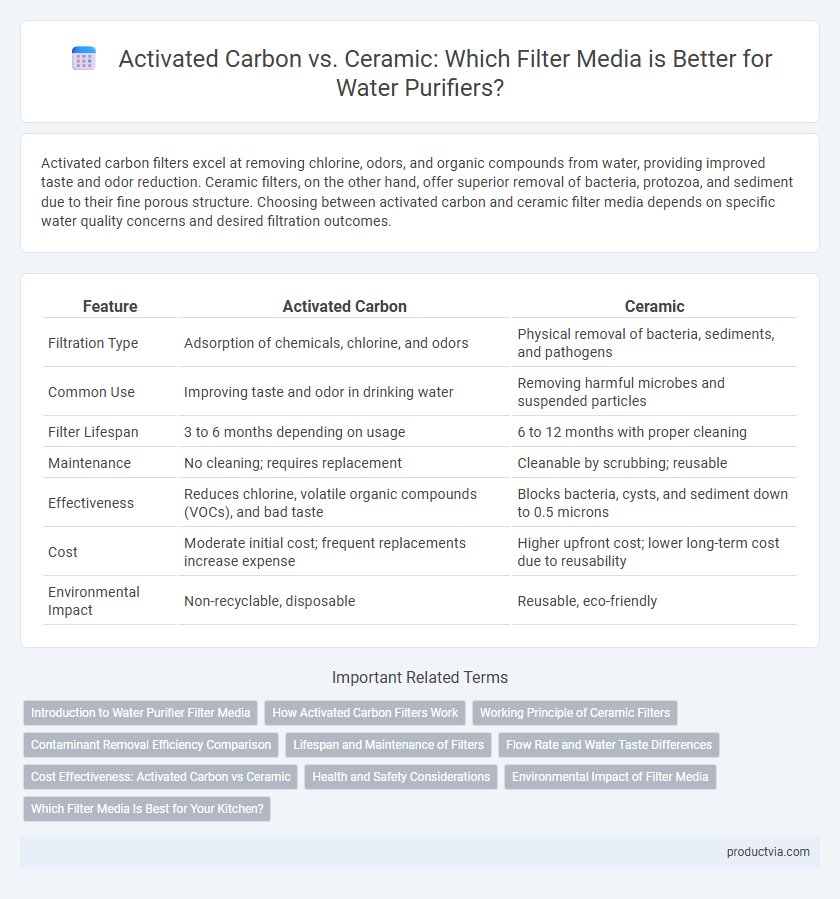Activated carbon filters excel at removing chlorine, odors, and organic compounds from water, providing improved taste and odor reduction. Ceramic filters, on the other hand, offer superior removal of bacteria, protozoa, and sediment due to their fine porous structure. Choosing between activated carbon and ceramic filter media depends on specific water quality concerns and desired filtration outcomes.
Table of Comparison
| Feature | Activated Carbon | Ceramic |
|---|---|---|
| Filtration Type | Adsorption of chemicals, chlorine, and odors | Physical removal of bacteria, sediments, and pathogens |
| Common Use | Improving taste and odor in drinking water | Removing harmful microbes and suspended particles |
| Filter Lifespan | 3 to 6 months depending on usage | 6 to 12 months with proper cleaning |
| Maintenance | No cleaning; requires replacement | Cleanable by scrubbing; reusable |
| Effectiveness | Reduces chlorine, volatile organic compounds (VOCs), and bad taste | Blocks bacteria, cysts, and sediment down to 0.5 microns |
| Cost | Moderate initial cost; frequent replacements increase expense | Higher upfront cost; lower long-term cost due to reusability |
| Environmental Impact | Non-recyclable, disposable | Reusable, eco-friendly |
Introduction to Water Purifier Filter Media
Activated carbon and ceramic are two essential filter media used in water purifiers to enhance water quality. Activated carbon excels at removing chlorine, volatile organic compounds (VOCs), and unpleasant odors through adsorption, improving taste and safety. Ceramic filters provide physical filtration by trapping bacteria, sediments, and pathogens due to their porous structure, making them ideal for microbial contamination removal.
How Activated Carbon Filters Work
Activated carbon filters work by adsorbing contaminants through a porous surface that traps impurities like chlorine, volatile organic compounds (VOCs), and bad odors, significantly improving water taste and safety. Unlike ceramic filters that primarily block bacteria and sediments, activated carbon excels at removing chemical pollutants and reducing harmful compounds at a molecular level. This makes activated carbon an essential component in water purifiers aimed at enhancing chemical filtration and odor removal in residential and commercial water treatment systems.
Working Principle of Ceramic Filters
Ceramic filters operate through a physical filtration process, using porous ceramic material to trap impurities, bacteria, and suspended solids from water. Unlike activated carbon filters that rely on adsorption to remove chemicals and odors, ceramic filters primarily filter out contaminants by size exclusion, ensuring clean, safe drinking water. Their fine pore structure allows them to remove pathogens without the need for chemicals or electricity, making them highly effective in microbial purification.
Contaminant Removal Efficiency Comparison
Activated carbon filters excel at removing chlorine, volatile organic compounds (VOCs), and unpleasant odors, significantly improving taste and reducing chemical contaminants in water. Ceramic filters effectively eliminate bacteria, protozoa, and sediment due to their fine microporous structure, providing superior microbial protection. Combining activated carbon with ceramic media often results in enhanced contaminant removal efficiency by targeting both chemical impurities and pathogens.
Lifespan and Maintenance of Filters
Activated carbon filters typically last 6 to 12 months and require regular replacement to maintain effective absorption of chlorine, odors, and organic compounds. Ceramic filters have a longer lifespan of up to 2 years with proper cleaning, as they trap bacteria and sediments through physical filtration rather than chemical absorption. Maintenance for activated carbon involves timely cartridge changes, while ceramic filters need periodic scrubbing to prevent clogging and sustain flow rate.
Flow Rate and Water Taste Differences
Activated carbon filters generally offer higher flow rates compared to ceramic filters due to their porous structure, enabling faster water filtration. Ceramic filters provide superior water taste by effectively removing bacteria and sediment without altering mineral content, whereas activated carbon excels at reducing chlorine and organic compounds that impact flavor. Choosing between the two depends on prioritizing either faster filtration with chemical taste removal or enhanced microbiological purification with moderate flow.
Cost Effectiveness: Activated Carbon vs Ceramic
Activated carbon filters offer cost-effective water purification by efficiently removing chlorine, odors, and organic contaminants at a lower initial investment compared to ceramic filters. While ceramic filters have a higher upfront cost due to their durable, microporous structure designed to eliminate bacteria and sediments, they provide long-term savings through reusability and minimal replacement frequency. Considering maintenance and lifespan, activated carbon filters require more frequent replacements, which can increase ongoing costs, making ceramic filters more cost-effective over extended periods despite the higher initial price.
Health and Safety Considerations
Activated carbon filters effectively remove chlorine, volatile organic compounds (VOCs), and unpleasant odors, contributing to improved water taste and safety by reducing chemical contaminants. Ceramic filters excel at eliminating bacteria, protozoa, and sediments due to their microporous structure, providing robust protection against microbial contamination. Selecting a water purifier with both activated carbon and ceramic media ensures comprehensive health safety by addressing chemical and biological impurities simultaneously.
Environmental Impact of Filter Media
Activated carbon filters excel in adsorbing contaminants but require energy-intensive production and frequent replacement, leading to higher environmental footprints. Ceramic filters offer sustainable advantages through reusable, long-lasting materials that reduce landfill waste and lower carbon emissions during manufacturing. Selecting ceramic media promotes eco-friendly water purification by minimizing resource consumption and enhancing durability.
Which Filter Media Is Best for Your Kitchen?
Activated carbon filters excel at removing chlorine, volatile organic compounds (VOCs), and improving taste and odor, making them ideal for kitchen water purification focused on flavor enhancement. Ceramic filters provide superior mechanical filtration by trapping bacteria, sediments, and protozoa, ensuring microbiological safety without affecting water taste. Choosing the best filter media depends on your water quality concerns: opt for activated carbon to enhance taste and remove chemicals, or ceramic for reliable pathogen removal and sediment filtration.
Activated Carbon vs Ceramic for filter media Infographic

 productvia.com
productvia.com